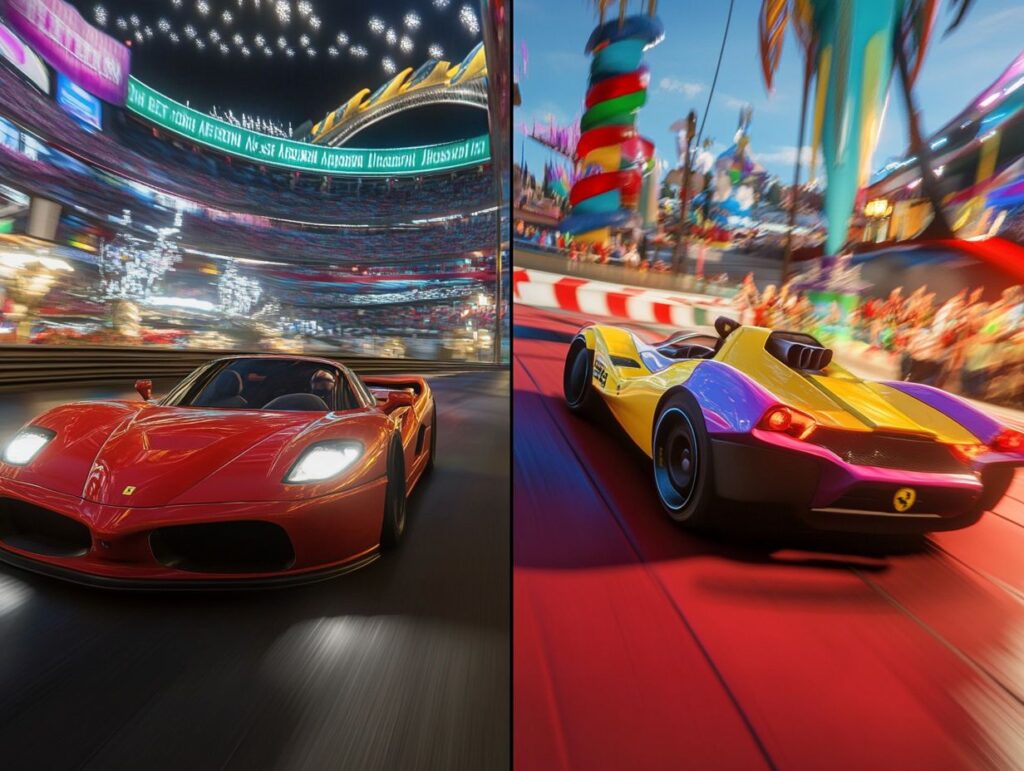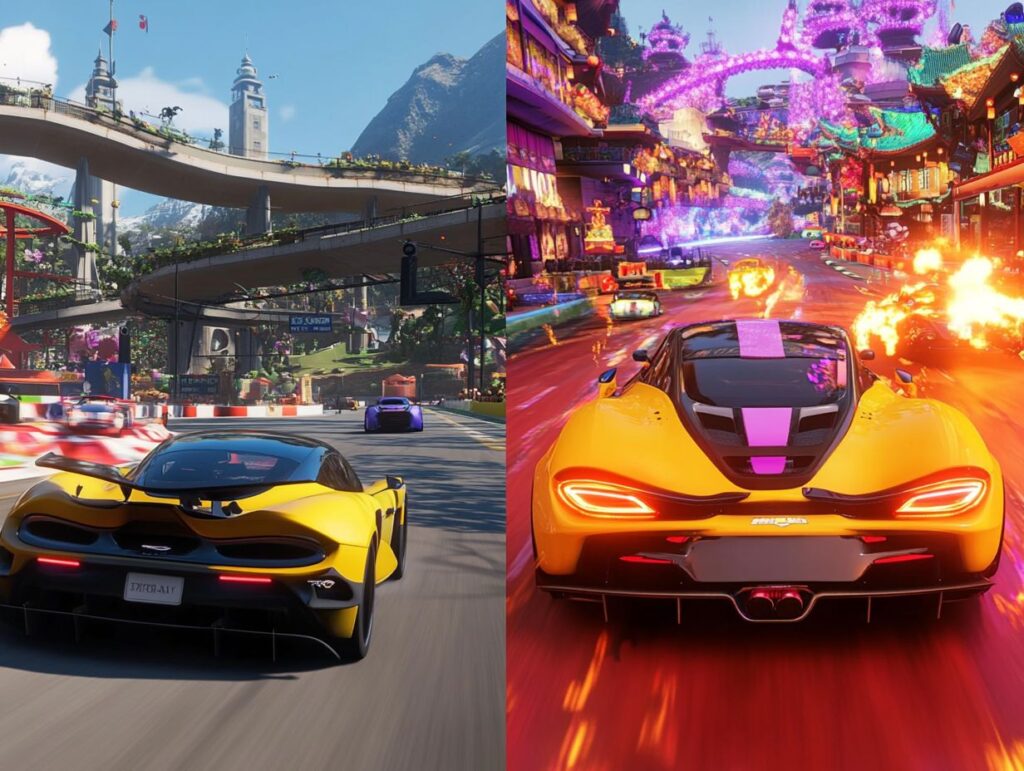Racing games have engaged gamers for decades, yet the decision between simulation and arcade styles can often present a significant challenge.
Each style provides a distinct experience, ranging from the realistic driving mechanics of simulation games that test one’s skills to the fast-paced and accessible enjoyment offered by arcade racers.
This guide delineates the key differences in gameplay, controls, and customization, assisting you in determining which style aligns best with your preferences.
Furthermore, it will provide valuable tips for beginners, along with a selection of popular titles to initiate your racing journey.
Table of Contents
Defining Sim and Arcade Racing Games

Sim and arcade racing games represent two distinct styles within the realm of racing video games, each catering to different player preferences. Sim racing games, such as Gran Turismo and iRacing, aim to deliver a realistic driving experience characterized by simulator physics that emphasize driving dynamics. In contrast, arcade racing games like Need for Speed and Burnout prioritize enjoyment and accessibility, often featuring fantastical settings and simplified controls.
Understanding the distinctions between these genres can assist players in determining which type of racing game aligns with their gaming style and expectations for gameplay immersion.
Sim racing appeals to enthusiasts who seek authenticity and challenge, frequently necessitating a steady hand and a comprehensive understanding of vehicle mechanics, track intricacies, and race strategies. Players aiming for a competitive edge may invest in advanced hardware, including wheel setups and pedals, to enhance their overall experience.
Conversely, arcade racing games attract individuals who desire fast-paced action and a more casual gaming approach. These titles typically incorporate outrageous stunts, vibrant graphics, and an adrenaline-fueled atmosphere, making them particularly suited for players in search of a thrilling escape rather than a painstakingly accurate simulation.
Consequently, the choice between these racing genres often reflects the player’s preference for either realism or exhilarating escapism during their gaming sessions.
Key Differences Between Sim and Arcade Racing Games
The primary distinctions between simulation and arcade racing games pertain to gameplay mechanics, realism, and user experience, impacting the manner in which players interact with each genre.
Simulation racing games are tailored for individuals seeking a comprehensive understanding of racing dynamics and driving physics. These games typically incorporate intricate car models, realistic environments, and detailed telemetry data.
Conversely, arcade racing games emphasize enjoyment and immediate gratification, providing simpler controls and placing less emphasis on simulation accuracy. This approach renders them accessible to a broader audience.
Gameplay and Realism

Gameplay and realism are fundamental to the experience of racing games, particularly when comparing simulation titles such as Gran Turismo and iRacing to their arcade counterparts.
Simulation racing games immerse players in environments that closely replicate real-world racing scenarios, employing advanced simulator physics and intricate car models to provide an authentic driving experience. This level of realism is essential for players who prioritize the development of their driving skills and seek to understand the nuances of vehicle performance, ensuring that every aspect of the gameplay is intentional and engaging.
Conversely, arcade racing games such as Mario Kart and Burnout adopt a more relaxed and thrilling approach. These games emphasize enjoyment and accessibility over hyper-realism, often featuring power-ups, exaggerated physics, and vibrant, imaginative settings. Players are able to engage in high-speed pursuits and perform extravagant stunts without encountering the steep learning curve typically associated with simulation titles.
While simulation racing emphasizes precision and realistic tire dynamics, arcade titles offer more forgiving handling, appealing to a broader audience. This distinction results in varied gameplay experiences, where one group of players is focused on mastering track layouts and tire management, while another group revels in the dynamic chaos of colorful tracks and inventive power-ups.
Controls and Difficulty
Controls and difficulty levels play a crucial role in shaping the player experience in racing games, significantly influencing the engagement of gameplay across various titles.
Simulation racing games typically incorporate intricate controls that closely mirror real driving mechanics, necessitating that players develop their driving skills to effectively manage complex car setups, tire management, and fuel usage. In contrast, arcade racing games provide more accessible controls with a lower learning curve, allowing players to enjoy the entertainment value without the requirement for extensive practice.
This differentiation between the two genres not only affects how players interact with their vehicles but also impacts the overall satisfaction derived from the game. In simulation games, the steep learning curve can present challenges; however, it often rewards players who dedicate time to mastering the intricacies of car handling and track dynamics.
Conversely, arcade titles emphasize immediate enjoyment, enabling casual gamers to engage in racing without the necessity of technical expertise.
Ultimately, the choice between a simulation experience and an arcade experience depends on a player’s preference for authenticity versus instant gratification, catering to a wide range of gaming preferences.
Customization and Progression

Customization and progression are essential components of racing games, enabling players to enhance their vehicles and personalize their gameplay experience.
In simulation racing games, these elements often transcend mere aesthetics, immersing players in the intricate details of vehicle dynamics and performance optimization. Players are afforded the opportunity to engage in extensive testing and adjustments, modifying factors such as tire pressure to improve grip or selecting aerodynamic kits to increase speed, thereby introducing a sophisticated layer of strategy.
Conversely, arcade racing games typically employ a more streamlined progression system, allowing players to quickly unlock new vehicles or power-ups that enhance their driving experience. This approach prioritizes a thrilling, fast-paced environment, delivering instant gratification rather than in-depth vehicle customization.
As a result, it appeals to a broader audience seeking immediate excitement on the track.
Which Racing Game is Right for You?
Determining the most suitable racing game for an individual is contingent upon personal preferences regarding enjoyment, realism, and the overall gaming experience desired.
For those who prioritize realistic gameplay characterized by intricate driving physics and an in-depth exploration of car performance, simulation racing games such as:
- Gran Turismo
- iRacing
may be the most appropriate choice.
Conversely, for individuals who favor fast-paced, exhilarating experiences set in fantastical environments and seek immediate enjoyment, arcade racing games like:
- Need for Speed
- Burnout
may be more fitting for their gaming sessions.
Factors to Consider

When selecting between simulation and arcade racing games, several critical factors must be considered that can significantly influence the overall gaming experience. Key aspects include the desired level of immersion, the complexity of gameplay mechanics, and the importance placed on a realistic driving experience versus accessible enjoyment.
A thorough understanding of these factors will aid in selecting a racing game that aligns with one’s gaming preferences and lifestyle.
For instance, players who favor a more authentic and immersive experience may be inclined to choose simulation games that provide realistic physics, intricate car mechanics, and accurately designed tracks that replicate real-world locations.
Conversely, those who prioritize enjoyment and fast-paced action might find arcade games more appealing, given their simpler controls and imaginative environments.
Additionally, the social components of racing games should not be overlooked; multiplayer modes can significantly enhance the enjoyment, fostering memorable moments of competition and camaraderie among players.
Ultimately, evaluating personal gaming priorities will facilitate a more satisfying selection process.
Examples of Popular Sim and Arcade Racing Games
A wide array of popular racing games exists within both the simulation and arcade genres, each delivering distinct gameplay experiences that appeal to varied audiences.
For those who appreciate simulation, these games typically showcase meticulously designed tracks, realistic car physics, and the ability to modify mechanics such as tire wear and fuel consumption, thereby creating an authentic racing environment.
Conversely, arcade titles emphasize accessibility and immediate enjoyment, featuring thrilling car chases, power-ups, and nitro boosts that maintain player engagement.
Enthusiasts seeking intense competition may be particularly attracted to the online multiplayer components of simulation racing games, while casual gamers might prefer the vibrant graphics and exhilarating stunts that are hallmark traits of arcade racing games.
Checkout The 24 best Racing games on Mobile
How to Get Started with Sim or Arcade Racing Games
Embarking on a journey with simulation or arcade racing games can be an exhilarating experience for new players seeking to enhance their driving skills and enjoy immersive gameplay.
For beginners, exploring titles within both genres is beneficial as it allows them to comprehend the various gameplay mechanics and identify what aligns with their gaming preferences.
Whether one opts for a simulation racing game that requires precision and strategic thinking or an arcade racing game that prioritizes enjoyment and accessibility, the essential approach is to engage with the virtual racing landscape and begin the exploration process.
Tips for Beginners
For individuals who are new to racing games, there are essential guidelines to ensure a rewarding and enjoyable experience. It is important to focus on mastering the controls, understanding the gameplay mechanics, and gradually enhancing driving skills while becoming familiar with the unique aspects of either simulation or arcade racing games.
Actively engaging with communities, viewing tutorials, and practicing consistently will significantly enhance the overall experience while maximizing enjoyment.
To further develop skills, it is crucial to explore various vehicles and track types, as each presents distinct challenges.
Participation in online forums and social media groups dedicated to racing games is highly encouraged, as these platforms provide opportunities to share experiences and obtain valuable insights from experienced players.
Setting specific objectives for each gaming session can be beneficial; whether aiming to achieve a personal best lap time or mastering a new racing technique, these goals can serve to maintain motivation.
It is important to remember that consistency is essential—regular practice not only refines driving abilities but also fosters a deeper appreciation for the immersive environments and exhilarating competition that racing games offer.









